Friday, 4 September 2015: Museum and rodizio
Written 18 June 2016
Okay, I admit. At this point, my notes, already pretty sketchy the last couple of days, peter out completely. From here on, I'm working from my photos only. I've never been this far behind before in writing a travel diary. I usually plan on winding each one up within a week or two after the trip ends, while things are fresh in my memory, but as I've explained in earlier entries, I was way behind anyway because of the firehose of information from the Viking folks, and then the sky fell on me shortly after we got back home. So I'll show you the photos, and I'll fill in what info I remember, supplemented with what I can glean from the photos I take of, e.g., historical markers and museum labels. Hope it's still of some interest.

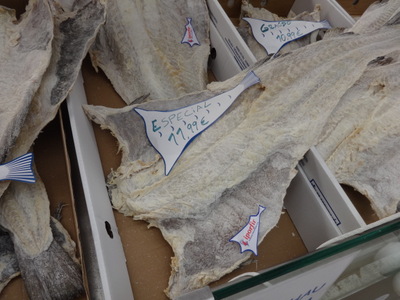 Our intrepid little group took the scenic route to the museum on Friday morning. We started with the city market, where that important staple, bacalão figured largely, both packaged and simpled stacked in bins. As you can see from the left-hand photo, they were all set up to ship it anywhere in the world.
Our intrepid little group took the scenic route to the museum on Friday morning. We started with the city market, where that important staple, bacalão figured largely, both packaged and simpled stacked in bins. As you can see from the left-hand photo, they were all set up to ship it anywhere in the world.
The photo at the right shows a single, whole, split, salted, and dried cod—an especially nice one, as it was priced higher than those near it, at 78 euros (per kilo or for the whole fish?). The characteristic roughly triangular shape of a dried cod was a common theme throughout Portugal, not just for the price labels here.
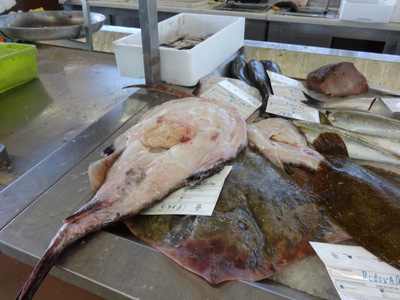
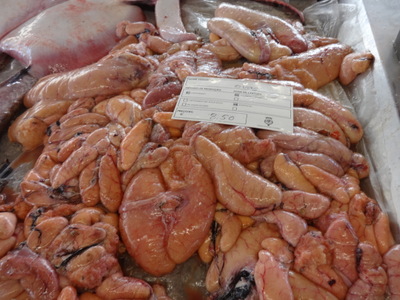 The market also had a small fresh-fish section, at least on Fridays. At the left here, a large monkfish lies on its back, displaying its liver, on top of a good-sized right-side-up ray, whose reddish nose is in the foreground. To the right of them is a good-sized flatfish of some sort.
The market also had a small fresh-fish section, at least on Fridays. At the left here, a large monkfish lies on its back, displaying its liver, on top of a good-sized right-side-up ray, whose reddish nose is in the foreground. To the right of them is a good-sized flatfish of some sort.
The photo at the right is a large bin of fish roe of all different sizes, simply labeled "ovas," eggs. 8.50 euros/kg.
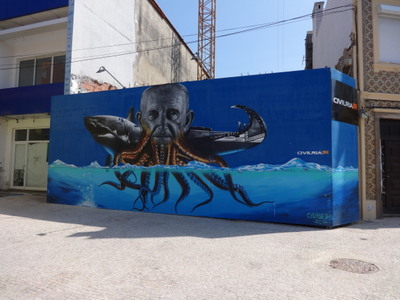
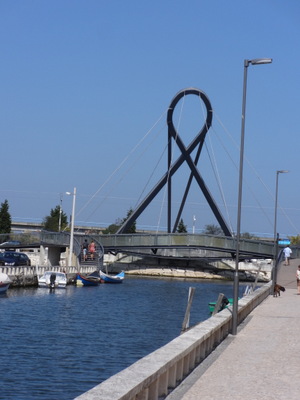 From the city market, we walked toward the main fish market and, on the way, encountered another wonderful mural. The shark head at the left blends into a salt-gondola tail labeled "Tubarão Atita, A932. The mural is signed "Carneiro 2014."
From the city market, we walked toward the main fish market and, on the way, encountered another wonderful mural. The shark head at the left blends into a salt-gondola tail labeled "Tubarão Atita, A932. The mural is signed "Carneiro 2014."
At the right, at last, here is a good overall shot of the fish-trap bridge. The slightly undulating walkway spans the canal; you can even see part of the far side of the circle below the slightly higher portion of the near side. It is supported by eight cables, which represent the eight provinces of Portugal that chipped in to sponsor its construction (in honor of a big soccer tournament).
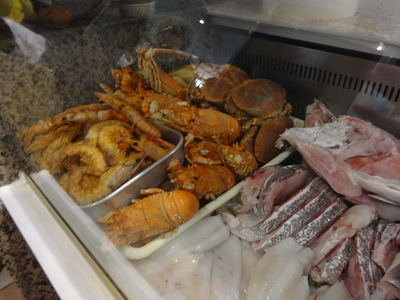
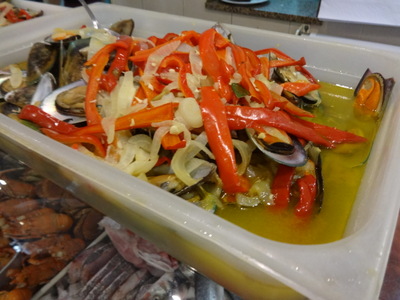 On this day, the main seafood market included a little more shellfish. At the left is an assortment of cooked crustaceans—crabs at the back, spiny lobsters, prawns, and (toward the front, beside the prawns) a slipper lobster.
On this day, the main seafood market included a little more shellfish. At the left is an assortment of cooked crustaceans—crabs at the back, spiny lobsters, prawns, and (toward the front, beside the prawns) a slipper lobster.
To the right of the crustaceas was a stack of fish steaks—crosswise slices of a large whole fish—topped with a split fish, cut side up.
The right-hand photo is of a large bin of cold cooked mussles in their cooking broth, topped with a heap of the peppers, garlic, onions, and cabbagecooked with them. Presumably one coujld purchase them by the pound to take home. I don't know whether they would be reheated or eaten cold.
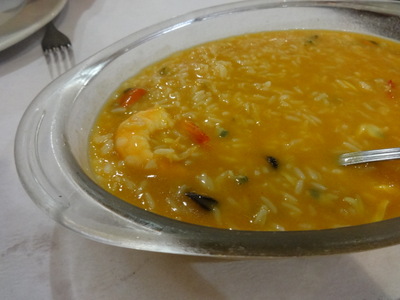
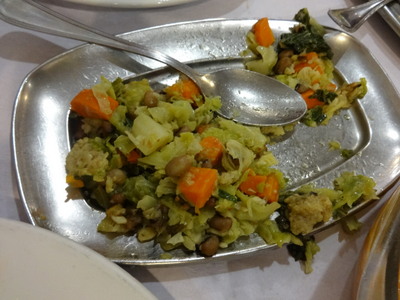 The scenic route also led through lunch. At the left here is a large bowl of soupy seafood rice. The seafood tended to sink, but you can see parts of a couple of shrimp and some small mussels peaking out.
The scenic route also led through lunch. At the left here is a large bowl of soupy seafood rice. The seafood tended to sink, but you can see parts of a couple of shrimp and some small mussels peaking out.
At the left is another platter of the ubiquitous Portuguese sautéed vegetables. I don't think it can be called "migas," because it has no bread bits in it.
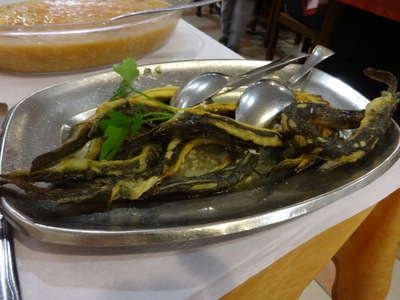
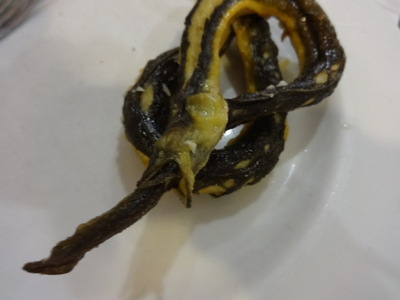 And here, of course, is my plate of eels. AS you can see, each time I ordered them, they got a little bigger.
And here, of course, is my plate of eels. AS you can see, each time I ordered them, they got a little bigger.
In the photo at the right, I've teased a couple of individuals out of the tangle so tht you can more easily see that they are curled into the "teardrop" configuration; the tail of each eel is inserted into the slit in the belly and out through the mouth.
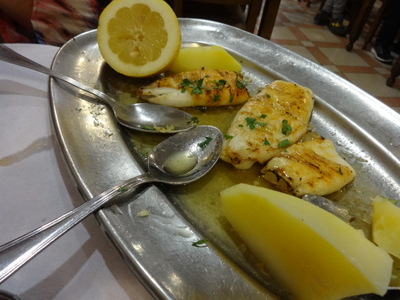
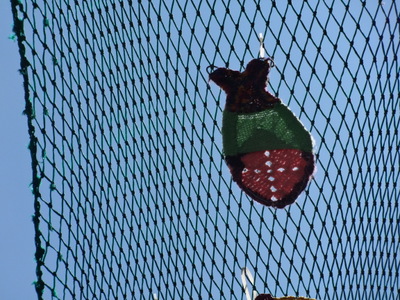
After lunch, we walked up a shopping street toward the musuem we had planned for the afternoon. Overhead, decorative fishnets have been hung and decorated with whimsical sea creatures. Some of them were stuffed, but this one seemed to be crocheted, over a heavy wire frame.
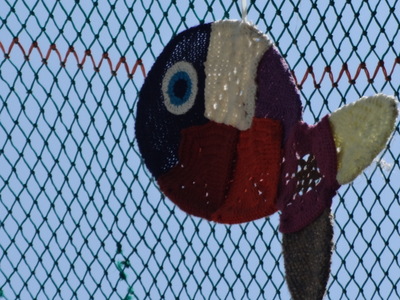
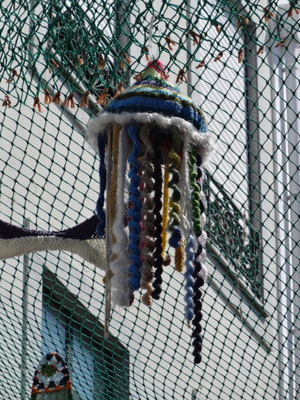 Here's a more elaborate crocheted fish, with a tricolor crocheted eye.
Here's a more elaborate crocheted fish, with a tricolor crocheted eye.
My favorite, though, was this delightful crocheted jellyfish, with its highly varied and colorful straight and curly tentacles.
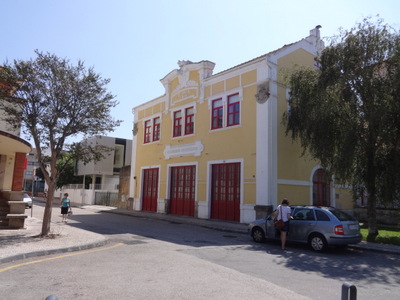
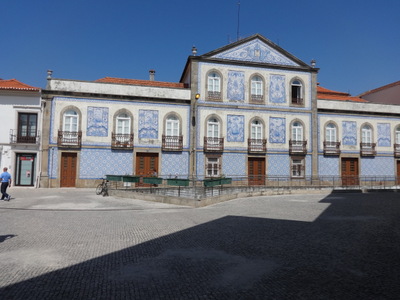 Here are a couple of particularly handsome buildings we passed on the way. The spruce yellow structure is (or at least was when the sign over the door went up) the volunteer fire department.
Here are a couple of particularly handsome buildings we passed on the way. The spruce yellow structure is (or at least was when the sign over the door went up) the volunteer fire department.
I don't know what the building on the right is, but it had a particularly beautiful set of tile panels, each one different.
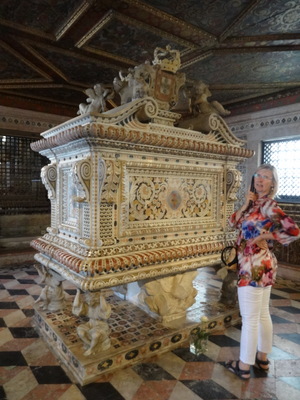
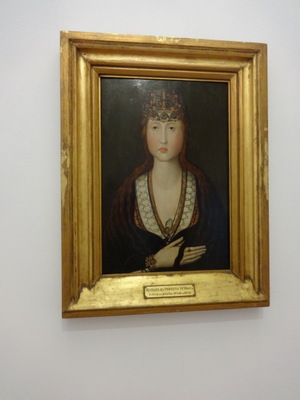 Just a short distance away, we came to the Museum of Aveiro (as opposed to the Museum of the City of Aveiro, in the ornate house down by the canal). Like most public institutions in Portugal, it's housed in an old convent. Because it's outgrown that, it also has a more modern wing.
Just a short distance away, we came to the Museum of Aveiro (as opposed to the Museum of the City of Aveiro, in the ornate house down by the canal). Like most public institutions in Portugal, it's housed in an old convent. Because it's outgrown that, it also has a more modern wing.
The photo at the left is the tomb of Princess Saint Joana (1452–1490), with Kathy for scale. She was the second child of King Afonso V of Portugal, and from her earliest youth wanted to become a nun. Unfortunately, her older brother died, so she became heir apparent (and therefore "Princess" rather than "Infanta") and was not allowed to take the veil. She acted as regent while her father was off on military campaigns, but she fought off all proposals of marriage. When her younger brother was born, she ceased to be heir apparent, but the people still called her Princess Joana. When her younger brother finally produced an heir, she considered her family duty fulfilled and joined the Dominican Convent of Jesus in Aveiro (the one that now houses the museum). She still had to leave the convent several time to act as regent as needed, and she continued to refuse proposals of marriage, including those from Charles VIII of France and Richard III of England. In 1693, she was beatified, and the people of Portugal have ever since called her Princess Saint Joana, even though she was never canonized.
The photo at the right is of a contemporary portrait of her. That image is also featured on the banner than hangs outside the museum.
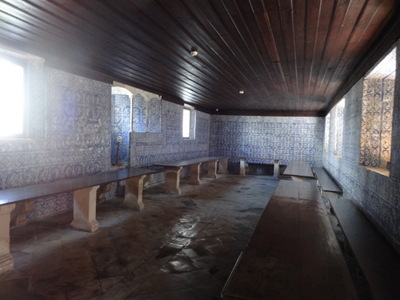
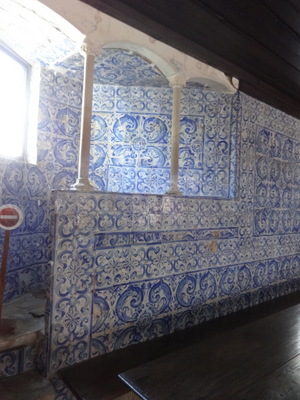 The long tiled room shown at the left is the nuns' dining room, where they sat on benches at this long wooden tables.
The long tiled room shown at the left is the nuns' dining room, where they sat on benches at this long wooden tables.
The photo at the right is a closer view of the small colonnaded niche you can see on the left wall of the room. That's where the nun sat or stood who was assigned to read aloud during meals. It's carefully positioned to take advantage of the good light from the window in its back wall.
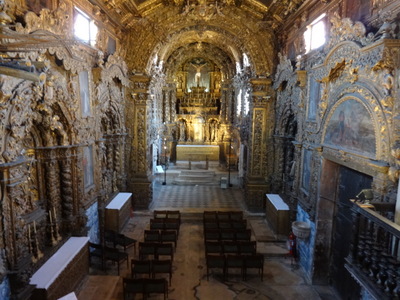
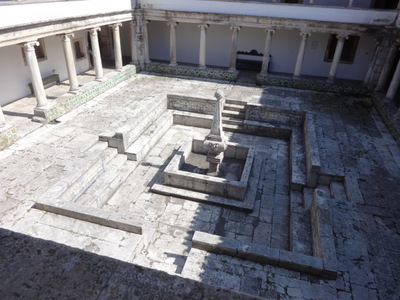 At the left here is a view (from the upper choir stalls) down into the ornate chapel. Pretty much everything that isn't tiled is gilded.
At the left here is a view (from the upper choir stalls) down into the ornate chapel. Pretty much everything that isn't tiled is gilded.
At the right is a view (also from the upper floor) down into the cloister. It was pretty sunbaked the day we were there, but lovely nonetheless. The glare makes them hard to see, but many of the surfaces are clad with colored tiles. A second gallery ran around it at the level where I was standing.
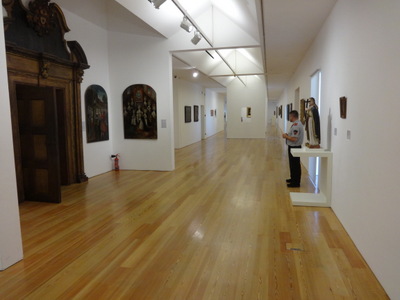
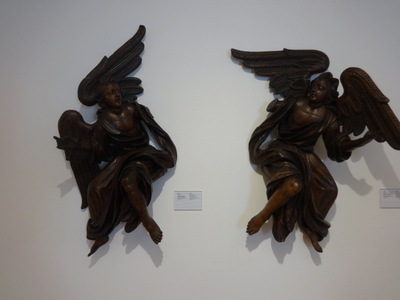 Paintings and works of art that were not part of the actual convent architecture were displayed in the more modern section of the building. This room housed mainly wood carvings.
Paintings and works of art that were not part of the actual convent architecture were displayed in the more modern section of the building. This room housed mainly wood carvings.
These two wooden angels, carved of old oak, formed a harmonious but not identical pair.
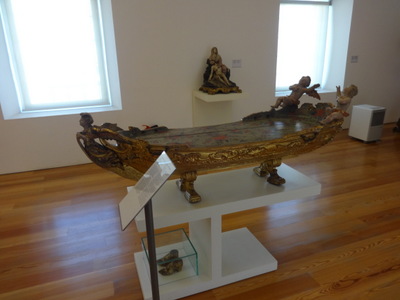
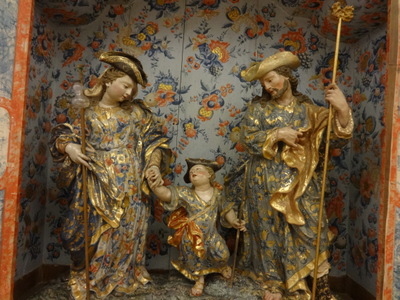 This "Boat of our Lady of Good Death" was carried in religious processions, but it is relatively small because it was used only inside the convent—members of the order could not participate in events outside. It originally carried a clothed figure of Our Lady of Good Death, of which only the elaborately embroidered shoes remain (in a case below the boat).
This "Boat of our Lady of Good Death" was carried in religious processions, but it is relatively small because it was used only inside the convent—members of the order could not participate in events outside. It originally carried a clothed figure of Our Lady of Good Death, of which only the elaborately embroidered shoes remain (in a case below the boat).
Another room housed religious diaramas, including this highly improbable and anachronistic "holy family," in which Joseph, Mary, and the Christ child are setting out, presumably for Santiago de Compostelle (note the glass gourd hanging from Mary's walking stick), dressed for entirely the wrong century!
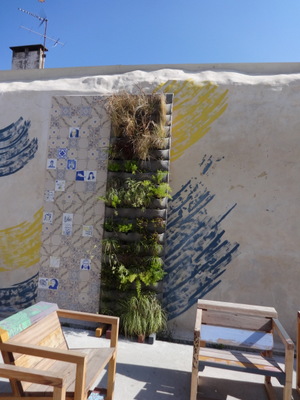
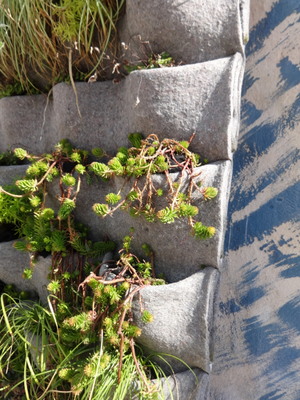 On our way out of the museum, we came across this wonderful planter, hanging against a courtyard wall.
On our way out of the museum, we came across this wonderful planter, hanging against a courtyard wall.
As you can see from the close-up at the right, it's made from a large sheet of some thick, heavy fabric, like a blanket, sewn into deep, loose, horizontal pleats, which are divided into smaller compartments by vertical lines of stitching. Then small drought-tolerant plants, mostly succulents, were stuffed into the pockets with a little dirt. I guess they turn a hose on it from time to time, or maybe it gets enough rain.
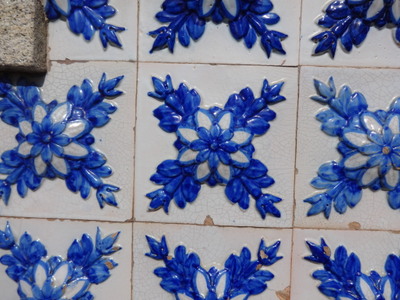
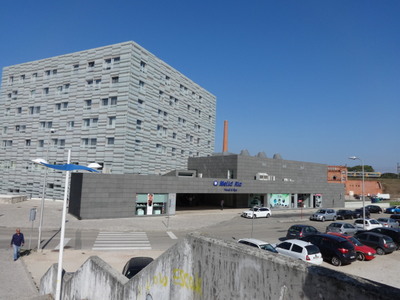 Here's yet another nice tile pattern. Each tile is three-dimensional—the highest point, the center of the flower, sticks out about an inch. The clay was presumably pressed into a mold before being dried, painted, and fired.
Here's yet another nice tile pattern. Each tile is three-dimensional—the highest point, the center of the flower, sticks out about an inch. The clay was presumably pressed into a mold before being dried, painted, and fired.
Finally, at the right is a particularly good view of our hotel, from the top of the "I [heart] Aveiro" stairs.
This was our last night together before we left for Lisbon to catch our flight home (Kathy and Buz stayed on a couple more days to meet friends), and both Kathy and I had hoped to find some good Brazilian food before we left—much as one would expect to find good Indian food in England. I accordingly poked around in Google and located "Espeto do Sul" (which I hoped meant "Southern Exposure" but turns out to mean "Southern Skewer"), a walkable distance from the hotel, that served rodizio style (the thing with the meat carved off skewers right at the table).
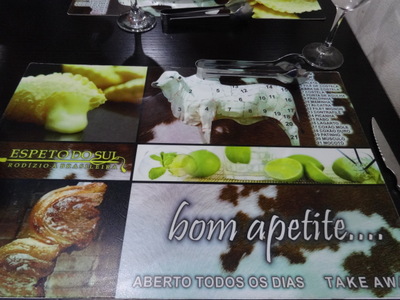
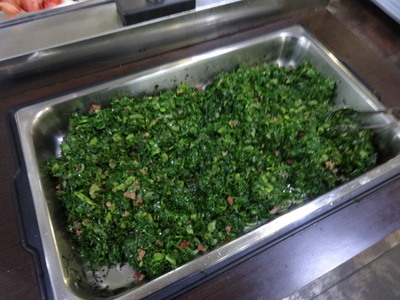 It turned out to be great! Here's the placemat, which provides photos of some of the food, as well as a diagram showing where each cut of beef comes from on the cow. It also wished us "bon appetit," specified that it was open 7 days a week, and advertised that you could get take-out.
It turned out to be great! Here's the placemat, which provides photos of some of the food, as well as a diagram showing where each cut of beef comes from on the cow. It also wished us "bon appetit," specified that it was open 7 days a week, and advertised that you could get take-out.
We started by serving ourselves some of these shredded and sautéed collards from the salad and vegetable bar.
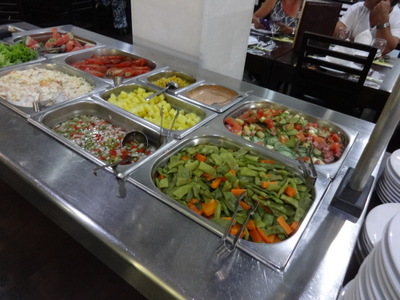
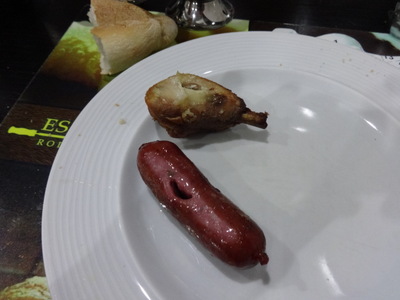 Here are some of the other choices: green beans cooked with carrots, several variations on salsa-like mixtures, sliced tomatoes, salad greens, salad dressing, cold corn kernels, watermelon, and pineapple.
Here are some of the other choices: green beans cooked with carrots, several variations on salsa-like mixtures, sliced tomatoes, salad greens, salad dressing, cold corn kernels, watermelon, and pineapple.
Then, when we turned our little table medallion green-side-up, they starting bringing food to us. The first could of meats to come around were little truncated chicken legs and small sausages; you can see where each of them was pierced by the skewer they were served from.
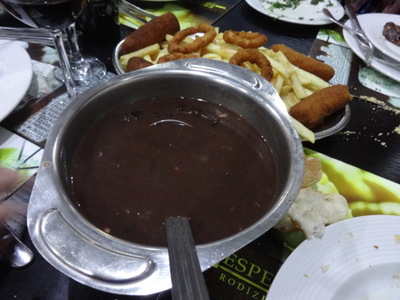
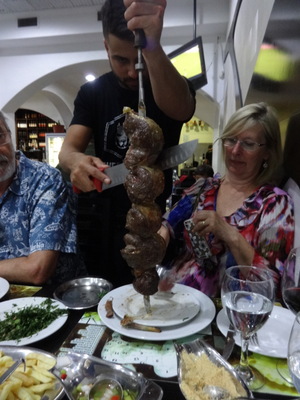 A big pot of black-bean (i.e., Brazilian style) feijoada appeared.
A big pot of black-bean (i.e., Brazilian style) feijoada appeared.
At the right, here, picanha (whole beef tri-tip) is being carved onto Kathy's plate. Picanha is usually considered the top of the line in Brazilian beef, but I actually like the short rib and skirt steak better. The only disappointment with this place is that it didn't serve its meat as rare as they did in Brazil.
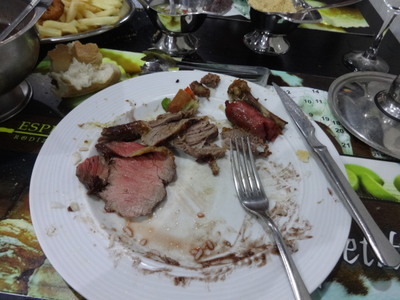
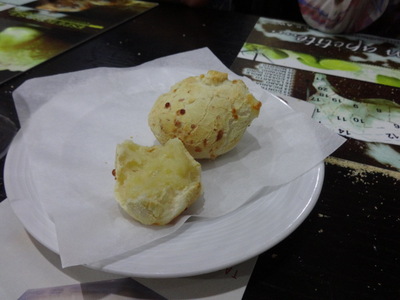 Here's my plate at a later stage, with some rib meat, a slice of beef (I forget which cut), and the remains of some feijoada. To go with the feijoada, they brought us a big bowl of white rice and a dish of farofa (toasted manioc flour) to sprinkle over it.
Here's my plate at a later stage, with some rib meat, a slice of beef (I forget which cut), and the remains of some feijoada. To go with the feijoada, they brought us a big bowl of white rice and a dish of farofa (toasted manioc flour) to sprinkle over it.
They also brought the crispy little round cheese breads (made with tapioca flour) that are so typical in Brazil.
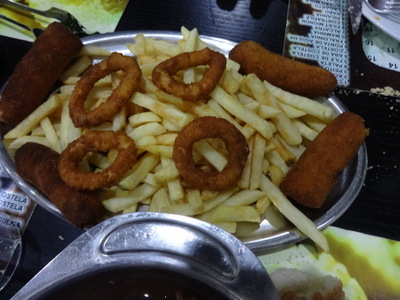
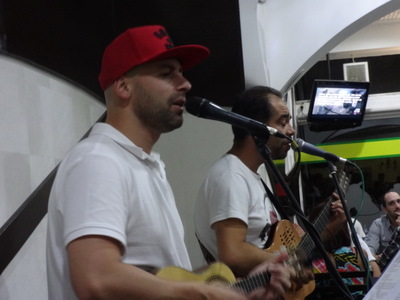 The meats continued to come—different sausages, pork, other cuts of beef, lamb, etc. And just to make sure we didn't go hungry, they brought this platter of fries, onion rings, and breaded and deep-fried bananas.
The meats continued to come—different sausages, pork, other cuts of beef, lamb, etc. And just to make sure we didn't go hungry, they brought this platter of fries, onion rings, and breaded and deep-fried bananas.
On top of all this, the place was also a sushi bar (Brazilian churrasarias typically put sushi on the salad bar), so some tables weren't even bothering with the meat but just ordered huge platters of sushi!
The crowning touch was a wonderful duo of singers, authentically Brazilian, who sang in the Brazilian Portuguese that Kathy spoke and ran through a long repertoire of songs that she knew and loved and that we immediately took a liking to, as well.
Finally, stuffed, we waved away the menu of elaborate ice cream desserts and staggered home to pack.
Previous entry
List of Entries
Next entry

 Our intrepid little group took the scenic route to the museum on Friday morning. We started with the city market, where that important staple, bacalão figured largely, both packaged and simpled stacked in bins. As you can see from the left-hand photo, they were all set up to ship it anywhere in the world.
Our intrepid little group took the scenic route to the museum on Friday morning. We started with the city market, where that important staple, bacalão figured largely, both packaged and simpled stacked in bins. As you can see from the left-hand photo, they were all set up to ship it anywhere in the world.
 The market also had a small fresh-fish section, at least on Fridays. At the left here, a large monkfish lies on its back, displaying its liver, on top of a good-sized right-side-up ray, whose reddish nose is in the foreground. To the right of them is a good-sized flatfish of some sort.
The market also had a small fresh-fish section, at least on Fridays. At the left here, a large monkfish lies on its back, displaying its liver, on top of a good-sized right-side-up ray, whose reddish nose is in the foreground. To the right of them is a good-sized flatfish of some sort.
 From the city market, we walked toward the main fish market and, on the way, encountered another wonderful mural. The shark head at the left blends into a salt-gondola tail labeled "Tubarão Atita, A932. The mural is signed "Carneiro 2014."
From the city market, we walked toward the main fish market and, on the way, encountered another wonderful mural. The shark head at the left blends into a salt-gondola tail labeled "Tubarão Atita, A932. The mural is signed "Carneiro 2014."
 On this day, the main seafood market included a little more shellfish. At the left is an assortment of cooked crustaceans—crabs at the back, spiny lobsters, prawns, and (toward the front, beside the prawns) a slipper lobster.
On this day, the main seafood market included a little more shellfish. At the left is an assortment of cooked crustaceans—crabs at the back, spiny lobsters, prawns, and (toward the front, beside the prawns) a slipper lobster.
 The scenic route also led through lunch. At the left here is a large bowl of soupy seafood rice. The seafood tended to sink, but you can see parts of a couple of shrimp and some small mussels peaking out.
The scenic route also led through lunch. At the left here is a large bowl of soupy seafood rice. The seafood tended to sink, but you can see parts of a couple of shrimp and some small mussels peaking out.
 And here, of course, is my plate of eels. AS you can see, each time I ordered them, they got a little bigger.
And here, of course, is my plate of eels. AS you can see, each time I ordered them, they got a little bigger.


 Here's a more elaborate crocheted fish, with a tricolor crocheted eye.
Here's a more elaborate crocheted fish, with a tricolor crocheted eye.
 Here are a couple of particularly handsome buildings we passed on the way. The spruce yellow structure is (or at least was when the sign over the door went up) the volunteer fire department.
Here are a couple of particularly handsome buildings we passed on the way. The spruce yellow structure is (or at least was when the sign over the door went up) the volunteer fire department.
 Just a short distance away, we came to the Museum of Aveiro (as opposed to the Museum of the City of Aveiro, in the ornate house down by the canal). Like most public institutions in Portugal, it's housed in an old convent. Because it's outgrown that, it also has a more modern wing.
Just a short distance away, we came to the Museum of Aveiro (as opposed to the Museum of the City of Aveiro, in the ornate house down by the canal). Like most public institutions in Portugal, it's housed in an old convent. Because it's outgrown that, it also has a more modern wing.
 The long tiled room shown at the left is the nuns' dining room, where they sat on benches at this long wooden tables.
The long tiled room shown at the left is the nuns' dining room, where they sat on benches at this long wooden tables.
 At the left here is a view (from the upper choir stalls) down into the ornate chapel. Pretty much everything that isn't tiled is gilded.
At the left here is a view (from the upper choir stalls) down into the ornate chapel. Pretty much everything that isn't tiled is gilded.
 Paintings and works of art that were not part of the actual convent architecture were displayed in the more modern section of the building. This room housed mainly wood carvings.
Paintings and works of art that were not part of the actual convent architecture were displayed in the more modern section of the building. This room housed mainly wood carvings.
 This "Boat of our Lady of Good Death" was carried in religious processions, but it is relatively small because it was used only inside the convent—members of the order could not participate in events outside. It originally carried a clothed figure of Our Lady of Good Death, of which only the elaborately embroidered shoes remain (in a case below the boat).
This "Boat of our Lady of Good Death" was carried in religious processions, but it is relatively small because it was used only inside the convent—members of the order could not participate in events outside. It originally carried a clothed figure of Our Lady of Good Death, of which only the elaborately embroidered shoes remain (in a case below the boat).
 On our way out of the museum, we came across this wonderful planter, hanging against a courtyard wall.
On our way out of the museum, we came across this wonderful planter, hanging against a courtyard wall.
 Here's yet another nice tile pattern. Each tile is three-dimensional—the highest point, the center of the flower, sticks out about an inch. The clay was presumably pressed into a mold before being dried, painted, and fired.
Here's yet another nice tile pattern. Each tile is three-dimensional—the highest point, the center of the flower, sticks out about an inch. The clay was presumably pressed into a mold before being dried, painted, and fired.
 It turned out to be great! Here's the placemat, which provides photos of some of the food, as well as a diagram showing where each cut of beef comes from on the cow. It also wished us "bon appetit," specified that it was open 7 days a week, and advertised that you could get take-out.
It turned out to be great! Here's the placemat, which provides photos of some of the food, as well as a diagram showing where each cut of beef comes from on the cow. It also wished us "bon appetit," specified that it was open 7 days a week, and advertised that you could get take-out.
 Here are some of the other choices: green beans cooked with carrots, several variations on salsa-like mixtures, sliced tomatoes, salad greens, salad dressing, cold corn kernels, watermelon, and pineapple.
Here are some of the other choices: green beans cooked with carrots, several variations on salsa-like mixtures, sliced tomatoes, salad greens, salad dressing, cold corn kernels, watermelon, and pineapple.
 A big pot of black-bean (i.e., Brazilian style) feijoada appeared.
A big pot of black-bean (i.e., Brazilian style) feijoada appeared.
 Here's my plate at a later stage, with some rib meat, a slice of beef (I forget which cut), and the remains of some feijoada. To go with the feijoada, they brought us a big bowl of white rice and a dish of farofa (toasted manioc flour) to sprinkle over it.
Here's my plate at a later stage, with some rib meat, a slice of beef (I forget which cut), and the remains of some feijoada. To go with the feijoada, they brought us a big bowl of white rice and a dish of farofa (toasted manioc flour) to sprinkle over it.
 The meats continued to come—different sausages, pork, other cuts of beef, lamb, etc. And just to make sure we didn't go hungry, they brought this platter of fries, onion rings, and breaded and deep-fried bananas.
The meats continued to come—different sausages, pork, other cuts of beef, lamb, etc. And just to make sure we didn't go hungry, they brought this platter of fries, onion rings, and breaded and deep-fried bananas.